Yoga Therapy at Sambhavna
At Sambhavna yoga has been found to be particularly beneficial for people suffering from chronic diseases involving the respiratory, musculo-skeletal, neurological and endocrine systems.
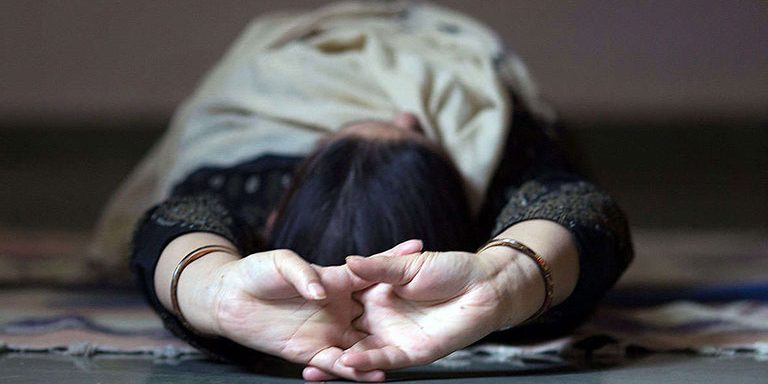
Yoga Therapy at Sambhavna
At Sambhavna yoga has been found to be particularly beneficial for people suffering from chronic diseases involving the respiratory, musculo-skeletal, neurological and endocrine systems.
In Sambhavna’s two airy yoga rooms, visitors are taught a number of different yoga ‘asanas’ (body postures), ‘shodhana kriyas’ (cleansing actions) and pranayama (breathing disciplines) by fully-qualified instructors.
The therapeutic effects of practicing Hatha Yoga – the over 2000-year-old science of uniting and coordinating the physical and mental aspects of one’s being through consciously attempted discipline of the body – have been successfully applied at Sambhavna.
Yoga has been found to be particularly beneficial for people suffering from chronic diseases involving the respiratory, musculo-skeletal, neurological and endocrine systems. Chronic respiratory disorders are the most prevalent complaints among gas survivors: two years of research at Sambhavna using spirometry testing demonstrated that regular Yoga produces significant and sustained improvement in lung function, decreases airway restriction and greatly lowers dependence on drug-based therapies.
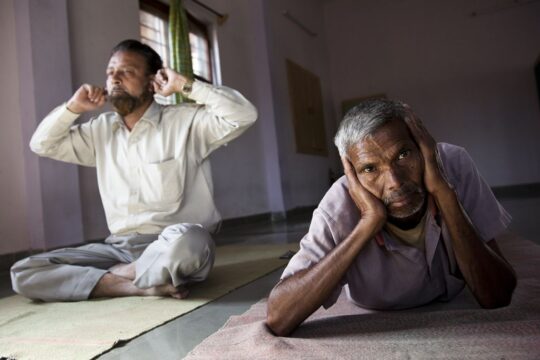
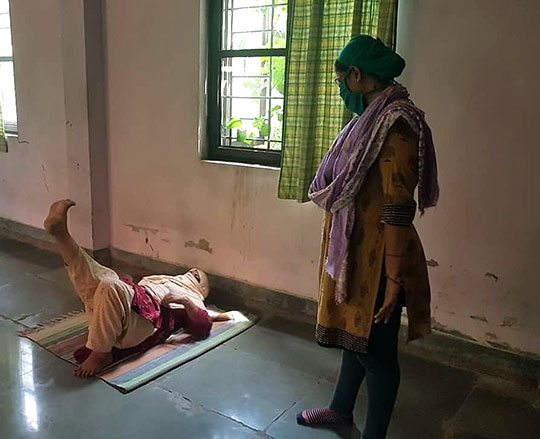
In 1999, Sambhavna was invited to present a paper to the sixteenth ‘World Congress of Asthma’ on the efficacy of its yoga treatments on respiratory disorders.(1)
In the study, more than half of the people practicing yoga for persistent breathlessness were able to remain completely off drugs they have had to take every day since the disaster. Naturally, Yoga costs nothing and once learned can be practiced outside of the clinic. Additionally, Yoga calls for the individual to be an active participant in his or her own healing.
Early yoga classes were poorly attended and, for the first year, it was difficult to get people to understand how it might help. Many people thought relief only came in the form of a pill. We faced cultural barriers too: lots of our patients are Muslim and thought Yoga was only for Hindus. But now, the current instructor, a Muslim woman, teaches Muslim and Hindu, man and woman, alike.
Taming Wayward Moons
These statements were made by young women who came to Sambhavna seeking help with the awful problems they had, until then, been suffering in silence and menstrual chaos is one of the least-known aspects of what is happening in Bhopal.
‘I writhe in agony like a fish out of water from the pain all over my body. I get my periods once in four months. I am told I must not mention my problems.’
‘I get terrible pain in my back and abdomen for five days during my periods. I get them every 15 days.’
‘In the last one month I have had periods thrice. Some times they come after three or even six to seven months. My periods last for 15 days. My sister has similar problems.’
‘I started my periods when I was ten. I get them once in three or six months. Once started they go on for 20 to 25 days, in which for 10 days bleeding is very heavy. I get giddiness, weakness, loss of appetite, irritability, numbness and tingling in the limbs when I have my periods. I also have breathing problems.’
In a city where many Muslim and Hindu women still wear the veil, intimate matters are not easy to discuss with strangers.
Our community healthworkers and volunteers talk to women about ‘moon problems’ and encourage them to come to the clinic, where as well as offering them modern treatment (thanks to the generosity of French writer Dominique Lapierre, Sambhavna has its own gynaecology clinic) we have pioneered new, drug-free therapies like Yoga.
Sambhavna’s Yoga Therapist, explains: ‘According to the principles of modern medicine, menstrual problems such as amenorrhoea could be due to systemic problems, hormonal imbalance and genital passage abnormalities. Irregular cycles could be caused by an underlying disease, specific problems of organs or by hormonal imbalance – pain during menstruation is caused due to contraction of the uterus and secretion of prostaglandin, so anti-spasmodics and anti-prostaglandins are used to relieve pain. Yoga can do this without drugs.’
Sambhavna carried out a study of how Yoga affected the menstrual problems of gas-affected women. The sample was 30 women, aged between 18 and 38, divided into a test group and a control group. Before the study started the test group received a month’s training in specified Yoga asanas. After this, for the study period of six months, they took no medicines for menstrual problems and did only Yoga, practicing at home, while the control group took medicines and did no Yoga.
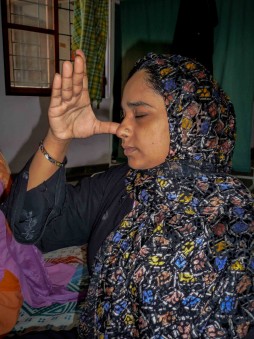
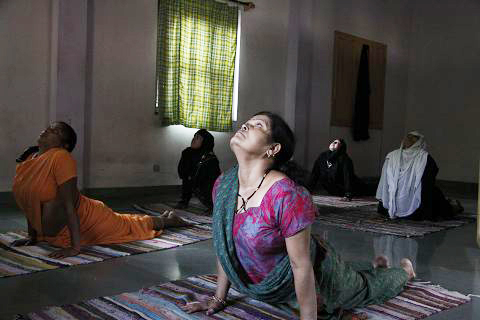
All women came to the clinic at least once a month with their menstrual charts, the test group women also using their visit to check their practice of the asanas with our Yoga therapist.
The menstrual charts were designed so that non-literate women could easily use them; simple graphic symbols replaced words. Women were trained to maintain the charts themselves, recording their cycle lengths, duration and amount of bleeding, intensity of menstrual pain and other associated symptoms, like weakness, lack of appetite, giddiness, pain in body, irritability and depression. Women using IUDs, oral contraceptives, breastfeeding women and women with diabetes and high blood pressure were not eligible for the study.
All women in the test group practiced a special set of asanas. For instance, Surya Namaskara improves transmission of prana vayu or ‘vital air’ in the body. It helps balance the nervous system and the endocrine. ‘Bhujangasana, Shalabha Asana, Dhanurasana and Ushtrasana mainly affect the ligaments and muscles of the pelvic region. Suptavajrasana and Naukasana affect the ovaries and uterus. Mild alternating pressure changes in these internal organs stimulates the autonomic nervous system as the walls of these organs undergo mild stretching and relaxation. Muscle tone is regulated and equilibrium is maintained in the system.
Women brought their menstrual charts to the clinic hidden in the folds of their dresses and shared them in complete privacy. The results were striking. Women in the control group showed no particular improvement in the regularity of their cycles, amount of bleeding or feelings of pain. In the test group more than half the women with abnormal cycles reported that they now had normal cycle lengths, 8 of the 10 women who had begun the study with abnormal bleeding reported that it was back to normal and 8 women reported relief from pain.
We now teach Yoga systematically to women with menstrual problems. Any therapy that brings relief without putting more chemicals into the already overburdened bodies of Bhopalis can only be a good thing.
XVI World Conference Of Asthma
At the World Conference of Asthma in Buenos Aires in 1999, Yoga techniques used at Sambhavna were hailed for their success. Yoga therapy was seen as an effective means to provide sustained relief to persons suffering from chronic breathlessness. The study presented showed that after six months of practicing Yoga, all participants found significantly increased lung function and decreased use of medicines.
References
1: A. Gupta, S. Durgavanshi and I. Eckerman (1999) ‘Effects of yoga practices for respiratory disorders related to the Union Carbide Gas Disaster in 1984′ The Sambhavna Trust, Bhopal India and The Population Health Unit, Nacka Hospital, Nacka Click here to view the paper.

